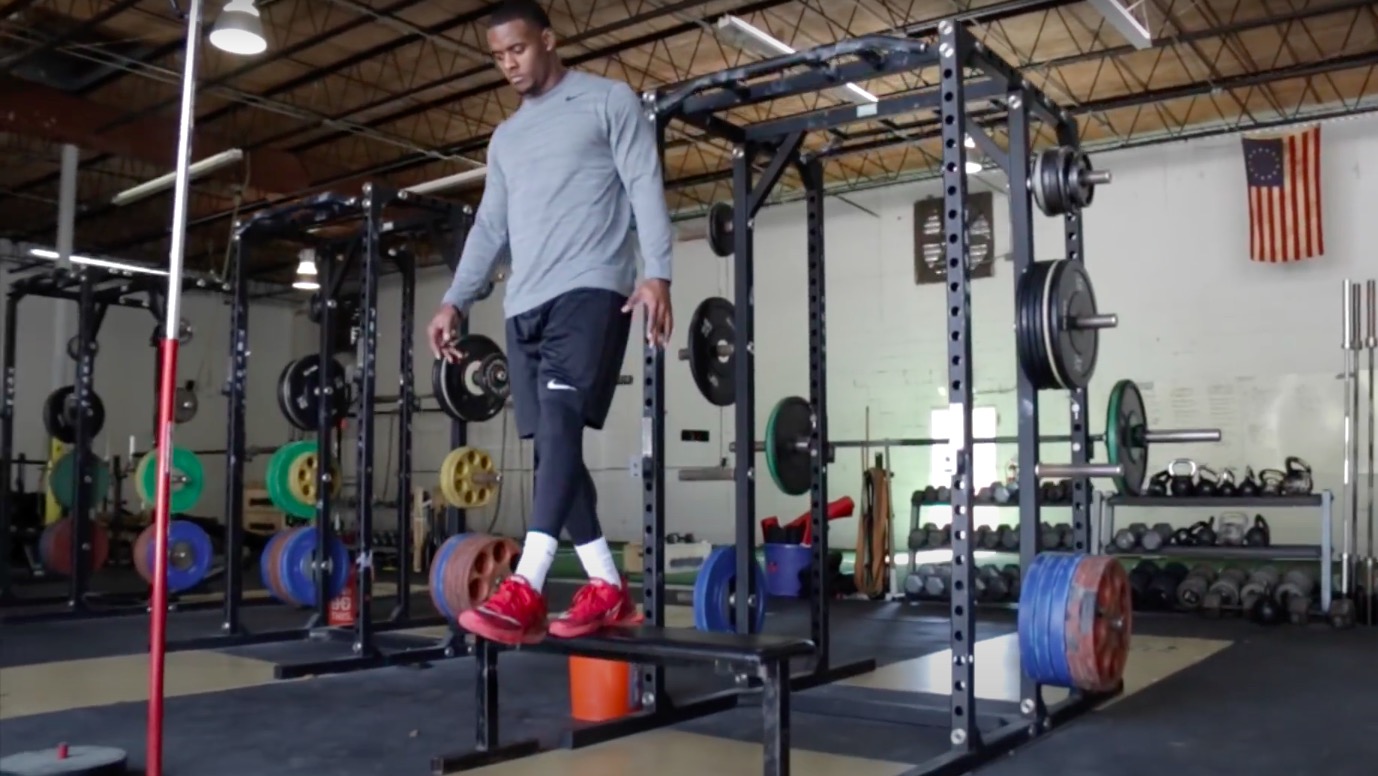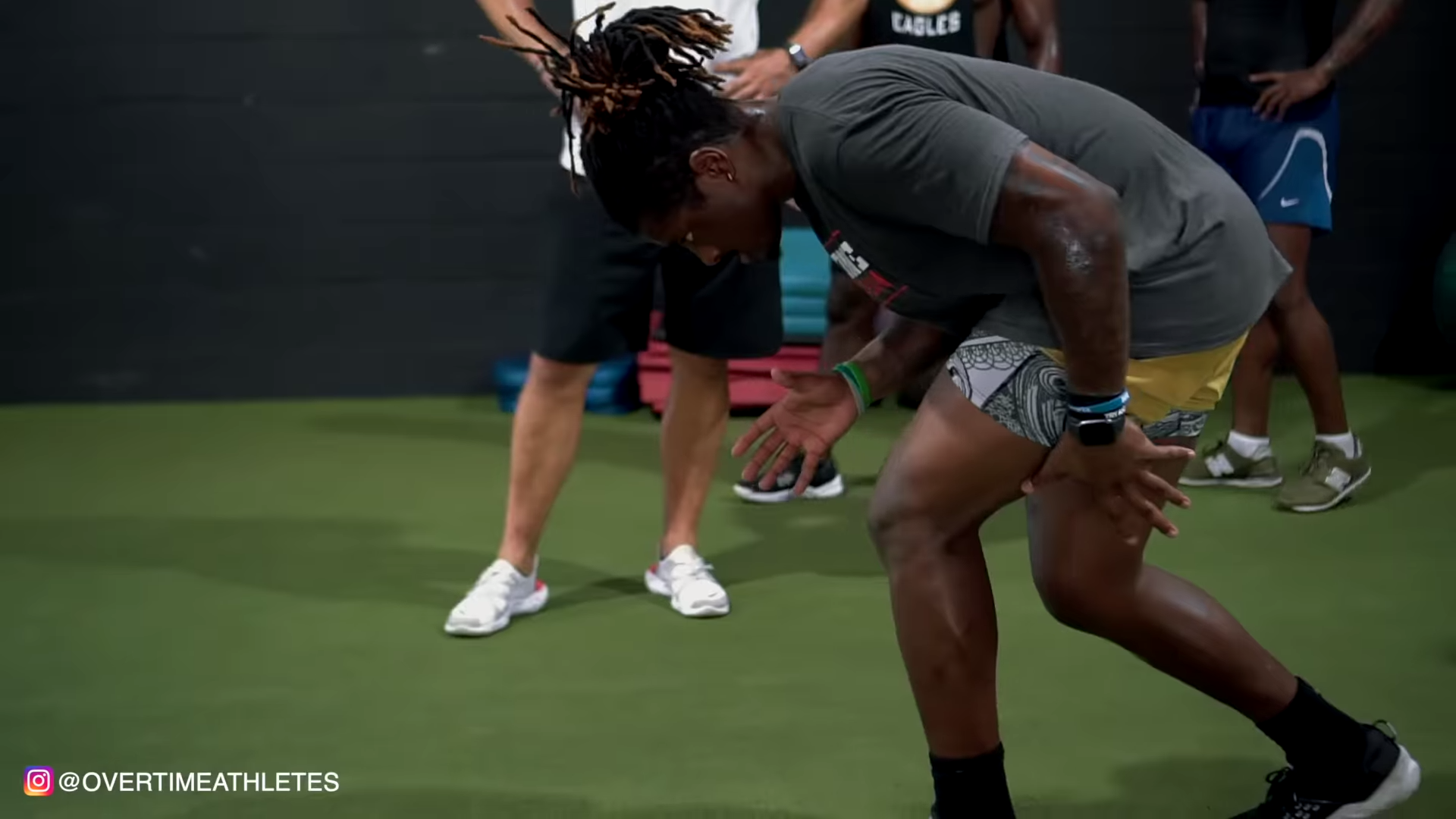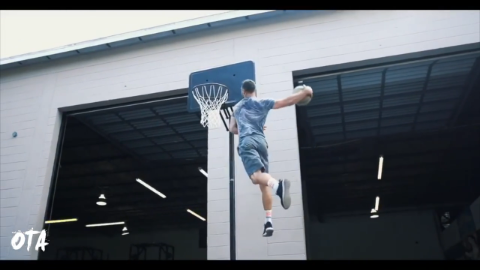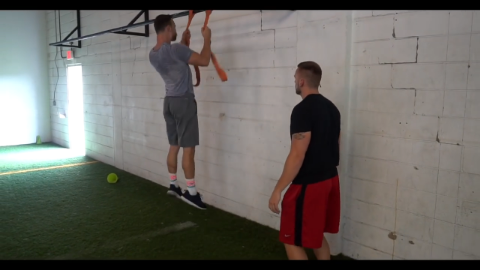For those of you looking for how to increase your vertical jump, this will depend on many factors – a major one being your overall training experience. If you’ve never trained before, or you’re a beginner (having trained less than a year), you should set different expectations than someone who’s been hitting the gym for 5 years. So the question is…
How Much Can You Actually Increase Your Vertical in 6 Months?
- As a newer or younger athlete, I’ll show you how you can increase your vertical jump by 8-10 inches in the next six months. Now don’t hop out of your seat just yet – this only applies to the athletes who remain regimented to the right training protocols. (AKA, keep reading).
- If you’re intermediate (have trained for 1-2 years), you can realistically increase your vertical jump by around six inches over the next 6 months.
- For someone who’s advanced, (training for more than 2 years), training can get you somewhere around 4 more inches on your vert.
It’s important to understand that newer or younger athletes (those we call untrained), have a much greater potential for improvement since they’re just starting out. If you’ve been putting in work for the past few years, good – keep training. Just because you won’t add another 10 inches onto your vertical doesn’t mean you should avoid putting in the work to reach your full potential.
6 Month Plan To Increase Your Vertical Jump:
Now that I’ve broken down a realistic goal for you depending on your years spent training, I want to provide you with the different training methods I recommend for athlete’s over the course of your career. You can use these plans to customize your own training experience. Consider this your blueprint for vertical jump training.
If you’ve got HUGE goals, you might be looking for something even more specific. I’d consider giving us a buzz over at OTA where you can work with me personally through remote coaching: click here for more info. If you’re just looking to get started, check out plan #1 below. If you’re more advanced and are looking to hit that magic mark of a 44″ vertical, scroll down a bit for plan #2 or 3.
PLAN #1: (0-1 YEARS OF TRAINING EXPERIENCE)
Beginners will have a very easy time increasing their vertical jump.
The reason for this is simply that their nervous system will rapidly respond to the new stimulus it is presented with. In this case, that new stimulus comes from training. The rapid response of your nervous system will result in fast adaptations. But you need to present your body with the RIGHT stimulus to capitalize on the blank slate nature of your nervous system.
In general, beginners will want to emphasize explosive movements and training fast over moving heavy weights slowly. This is to develop fast twitch muscle fibers that will help with your bounce.
Here are 5 training modalities you should focus on as a beginner to increase your vertical jump:
Quality Movement

Quality movement is EVERYTHING as a beginner. The reason for this is simple: It’s harder break bad habits than build new ones. Movement is new to you, so it’s important we instill these good habits.
This means you spend time learning to jump and land properly. Be meticulous when you perform movements like squats, trap bar deadlifts, or any other weighted movements.
When you do this, you’ll avoid the headache of circling back to enhance movement patterns.
Connected Jumps
I use connected jumps at all levels, but they’re especially important beginners.
Connected jumps can enhance the energy efficiency and force production capacity of all of the joints involved in the vertical jump. This includes the ankle, knee, and hip.

Some of my favorite connected jumps for beginners include:
- Pogo Jumps
- Squat Jumps
- Lunge Jumps
For more check out this bodyweight workout for vertical jump.
Again, these may see simple, but they’ll be monumental in your journey to a higher vertical jump.
Unilateral Plyometrics
Another critical piece of your vertical jump training for beginners are unilateral plyometrics.
Unilateral plyometrics are critical for a couple of reasons.
- Unilateral plyometrics work each leg’s ability to absorb and produce force individually.
- They are critical for building stability in the lower extremities.

Some of the best unilateral plyometrics you can perform are:
- Single Leg Box Jumps
- Single Leg Tuck Jumps
- Power Skips for Height
Stick with those and you’ll be on your way to a higher vertical. (for a list of some single leg plyo’s, click here)
Force Absorption Training
Force absorption is another massively overlooked aspect of vertical jump training.
Many athletes look to box jumps and other “fancy” plyometrics to put more bounce in their step. But, what they don’t realize is the more force you can ABSORB, the more you can produce.

Basically force absorption will be key if you want to increase your vertical jump. So how do we train this?
Begin with eccentric-focused movements which emphasize the “lowering” portion of movement. In other words, you’ll focus on the lowering phase as you return to the bottom in a back squat.
Begin your eccentric training by lowering in a controlled manner during all of your movements.
Jumps, squats, deadlifts, lunges, and more should all be done with a slow and controlled eccentric phase.
As you feel yourself gaining more eccentric strength, progress this by adding in tempos. You can start playing around with the length of your eccentric phase going from 2, 3, 4 seconds and longer.
Resisted Plyometrics

Finally, you’ll want to implement resisted plyometrics into your training. These could be almost any modality you can add resistance to:
- Box Jumps
- Pogo Jumps
- Squat Jumps
- Lunge Jumps
- Low Squat Jumps
And many more… check out this guide to foundational plyometrics for explosiveness.
To start make sure that your resisted ploys are done no heavier than 10% of your bodyweight. This allows you to build proportional strength and focus on your quality of movement.
PLAN #2: (1-2) YEARS OF TRAINING EXPERIENCE)

If you’re at an intermediate level, chances are you’ve already spent your newbie gains. Not to worry, that just means you’ll need to take a more dialed in approach towards your training. With commitment to the right plan, you’ll be able to start maximizing your potential to increase your vertical jump.
At this stage, you’re going to perform more strength training than at a foundational level, and finally advance your plyometric training to work on reaction. It’s important to note that you should still look over and even perform the modalities laid out in Plan #1. If your foundation is poor to start with, none of what I’m about to share will make much of a difference…
If you’ve already been training your vert as well, be sure to check out 5 commons mistakes made when training to increase your vertical
Reactive Plyometrics
In the beginner stages, you worked on a fundamental level to build your force absorption capacity. Reactive plyometrics will help to build on both of this.
Reactive plyometrics ask you to react off the ground and immediately into another jump.
A perfect example of this is a rebound vertical jump in which you step off of a raised surface, react off the ground, and explode into another powerful jump.

Some of my other favorite reactive plyometrics are:
- Depth to vertical jump
- A Depth to broad jump
- Depth to split lunge
- Depth to MB Vertical toss
- Single leg squat drop to box jump
To see bunch more of these demonstrated, (see this blog post). The key to each of these movements is to minimize ground contact time and quickly transition into an explosive jump.
Absolute Power Training

Next let’s build off your base of force absorption.
Now that you’re confident training this in isolation, let’s look to remove the stretch reflex. This is the portion of a movement where your muscle’s conserve and tend to hold you back.
By using an exercise like the seated box jump (above), you inhibit the stretch reflex and learn to produce more force!
That’s why I call this absolute power training where the athlete has to strictly rely on elasticity in the lower body.
You can also perform this kind of training with isometric holds before jumping. If you take a box jump for example, lower down to your normal depth for a jump, hold for 3 seconds, then explode up.
This again, will limit the stretch reflex and help build your absolute power.
Triphasic Training
As I mentioned before, this stage places more of an emphasis on weight training.

While beginners focused more on lighter weight movements at a quicker rate, here, we’re going to crank things up a notch with triphasic training.
If you aren’t familiar, triphasic training is one of the methods I used to increase my vertical by 12 inches (more on that below). In the most simple terms possible, this modality emphasizes each portion of a lift to build on certain qualities.
This can be broken down in three training blocks, each with a specific focus:
- Eccentric Training
- Isometric Training
- Concentric Training
I have a video series on YouTube that goes much deeper into this that you can watch here.
Triphasic training allows you to build and progress on a foundation more than traditional weight training can, thereby helping you to become more athletic and increase your vertical jump.
PLAN #3: (2+) YEARS OF TRAINING EXPERIENCE)

Finally, we arrive at advanced athletes.
These are athletes who have been lifting for 2+ years. Their nervous systems have seen a lot of stimulus, and it’s going to take everything and the kitchen sink to see an increased vertical jump.
But have no fear. I did it myself and I’m here to show you how.
Just like at the intermediate stage, you’ll utilize all the training methods from the previous stages to increase your vertical. What happens now is a few additional, advanced drills that will help get to where you wanna be.
Check out my top 5 weighted exercises for vertical jump.
Sports-Specific Vertical Jump Training

Everyone has a reason for jumping higher. What’s yours?
Some just want to dunk. Others want the ability to have a clean spike over the net or to leap over the the incoming linebacker to nab a pass.
Whatever your “why”, in this stage, you’re going to perform jumps that are specific to that goal.
For example, if you want to dunk, practice dunking. If you want to spike the ball, practice that. If you’re a hooper looking to grab more boards, practice continuous jumps touching the rim for time.
You’ll have to get a little creative here, but these maximum effort jumps will surely put more bounce in your step.
Accommodating Resistance

Accommodating Resistance is my favorite lifting method to develop power and it’s the best in my opinion.
Why?
Well, if you’ve ever met a powerlifter, chances are they didn’t have a 40 inch vertical. In fact, they probably weren’t very athletic at all. But, they can lift a TON of weight.
They can produce a lot of force, but not quickly enough to move down the field or court. They have strength, not power.
And in simple terms, power comes from moving weights fast which is what accommodating resistance encourages you to work on.
Accommodating resistance in the form of bands, forces you to accelerate through the entire range of movement. Then you can perform that movement faster than you would once you remove the bands.
In general, I like to keep the weight no more than 70% of your one rep max.
Contrast Training

Contrast training is simple. You’ll perform a heavy movement with resistance, immediately followed by a weightless and explosive drill of a similar pattern.
For example: a squat followed by a vertical jump.
When you do this properly, your muscular performance should be heightened it increase your vertical jump.
Why?
Post-activation potentiation. Post-activation potentiation is essentially an increase in your muscular performance due to the muscle’s contractile history. In other words, the body can work at a near-max effort level of contraction for longer.
This training particular methodology seriously enhances your vertical jump training by converting strength into power.
How I increased my vertical jump by 12″ in 9 months.
It was pretty crazy… Unbelievable actually.
A few years back, I increased my vertical by 12 inches in just 9 months after years of training for college football and the NFL combine.

How? With this vertical jump plan.
It’s called the Elite Vertical Academy.
And a few months ago, I released this all new program to help athletes all over the world jump higher. Whether they wanted to dunk, catch more passes, or grab more boards, they found solace in EVA.
Since I know you’re serious about your vertical jump training (as you just read this entire post)…
I want to offer you access to the Elite Vertical Academy for an exclusive discount.
You won’t find this anywhere else.
Skeptical? Click the link below to read more about Elite Vertical Academy and the impact it’s had on athletes around the world.
That way as an athlete with big goals, you can make an informed decision:

